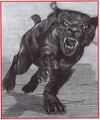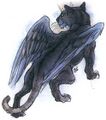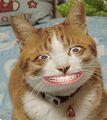Cat: Difference between revisions
1d4chan>A Walrus |
1d4chan>A Walrus |
||
| Line 146: | Line 146: | ||
=Warhammer 40k= | =Warhammer 40k= | ||
[[Image:SQUAD BROKEN.JPG|thumb|Cats are also known to caus- SQUAD BROKEN!!]] | [[Image:SQUAD BROKEN.JPG|thumb|Cats are also known to caus- SQUAD BROKEN!!]] | ||
It was confirmed in one of the [[Ciaphas Cain]] books that humans still keep cats as pets. And when you consider how many rats and shit must be in those hive cities, it's not exactly surprising. They would be quite at home on a ship of the Imperial Navy, but sadly, many might also just be food for hive world inhabitants and feral worlds, anywhere where food is hard to find (much of the Imperium). However IRL cat meat tastes rough, is stringy and doesn't have much flavor. So they'd have to be very desperate to eat cats. [[Dogs]] on the other hand.... | It was confirmed in one of the [[Ciaphas Cain]] books that humans still keep cats as pets. And when you consider how many rats and shit must be in those hive cities, it's not exactly surprising. They would be quite at home on a ship of the Imperial Navy, but sadly, many might also just be food for hive world inhabitants and feral worlds, anywhere where food is hard to find (much of the Imperium). However IRL cat meat tastes rough, is stringy and doesn't have much flavor. Since cats are obligate carnivores it's also inefficient due to thermodynamics. So they'd have to be very desperate to eat cats. [[Dogs]] on the other hand.... | ||
=Dreamlands= | =Dreamlands= | ||
Revision as of 05:55, 27 October 2022

The Felidae family, general known as cats, are a group of carnivorous mammals that has species native to all continents except Antarctica. Indeed, they are only family within the Carnivora order where all members are carnivorous. Cats include several of the most dangerous and iconic predator animals including the lion, tiger, bobcat, leopard, cheetah and puma.
Cats have the ability to break spacetime occasionally by expanding to fill all available space, or disappear while in plain view, abilities accurately depicted in Dwarf Fortress.
Real Life Housecat Evolution and Behavior
While humans have domesticated the cat's arch-rival, the dog, for over 10,000 years, cats have only been domesticated for a few thousand. Even using wild felines as execution method is only known to go back to the time of Alexander the Great (c. before 300 BC). While dogs have been used to fill a variety of tasks, domestic cats are primarily used for pest control, since they kill rodents and other threats to stored food without taking much interest in the supplies themselves. Since cats tend to eat these pests, they are fairly self-sufficient guards.
Of small note, it's argued by some biologists that cats effectively domesticated themselves; once humans invented agriculture, they started having a lot of juicy juicy rodents in their foodstores, leading to cats starting to come to prey on said animals. As such, cats were never directly dependent on humans for food.
Further, cats were stealth predators who were also subject to predation in turn, thus explaining their fondness for hiding in enclosed spaces and frequent skittishness around strangers.
As a result of these factors, cats have stayed unusually independent for a domesticated animal.
Feral Cats have adapted to living in Australia. Yes, these little shits could survive in a fucking Death World if there are not enough natural predators to keep their population in check. Of which there are only two on the continent. Even a house cat will kill smaller wild animals because living pest control as stated above is why humans adopted them. Unlike dogs, cats have yet to lose the instincts of their wilder cousins.
Dungeons and Dragons
Domestic cats have long been an option for a Dungeons and Dragons familiar. Larger cats are typically favored forms of Druids who transform into animals or take animal companions. This is especially so in 3E, as they tend to have Pounce, which dramatically increases their attack power by letting them full attack and move on the same turn.
The Killer Housecat
In 3rd Edition Dungeons and Dragons, house cats have stats that make them incredibly deadly combatants for their apparent harmlessness and low Challenge Rating. Thanks to a tiny size and high dexterity, a cat has an armor class that makes it as hard to hit as a man in a chain shirt. The cat is actually harder to hit, since that AC is all touch AC, so splash weapons and energy rays will not save you. They are also very stealthy and win initiative, so they can ambush easily.
A cat has three natural attacks, all doing 1 damage each; statistically, a cat will virtually always kill a level one Commoner one on one, and possibly even a level one Wizard if there's no familiar helping them fight back, making them more dangerous than bandits and marauders to a human city since they are everywhere. Even if he can get casting off (which is already a resource expenditure far in excess of its supposed CR), the few first level Wizard spells available aren't that likely to work on the monster thanks to low damage that is likely halved (and if it's a familiar attacking you, outright avoided) by the cat's high reflex save. More meaty classes fare better, but still need disproportionate effort to kill it.
Pathfinder nerfs them slightly, but only through a minor, easily overlooked system wide change: Damage reduced to less than one by damage penalties does one non-lethal damage (in 3E this was still lethal damage). This means a victim has a chance of being rescued after being KOed, but before the cat finishes them off. This does raise the question of how cats can actually kill rats without first KOing them; then again, that's not unrealistic to RL cats, who usually try to cripple their prey before going in for the killstroke (because the killstroke generally leaves the cat vulnerable, so making sure their prey can't fight back is important).
The "killer housecat" phenomenon is well known enough that it's referenced regularly in 3e forums and its derivatives as a standard deadly "monster" for its CR and to emphasize how squishy low level Wizards are, as well as other games and media in or near the /tg/-sphere.
Special Cats
The following kots appear in D&D:
- Caterwaul: Felines with dark blue fur and prehensile tails. They emit a high-pitched screech that deals damage. They collect shiny objects.
- Cath Shee: Magical cats bred by elves.
- Change Cat: A domestic cat that can transform into a cheetah.
- Crypt Cat: Mummy cats.
-
-
-
Crypt cat right
- Ebon Tiger: Tigers made of black fire from the Ethereal Plane.
- Feliquine: A lion with the hindquarters of a horse.
- Grudgling: Cats with the heads of humans, elves or dwarves that are kept as household pets by rakasta in Mystara.
- Luck Eater: A Gotcha Monster that mind controls all creatures within 30 ft. to bring it with them wherever they go and protect it from all harm. It also gives a -5 penalty to surprise rolls, -2 to all other rolls, and -10% for all attacks to those within this range. If no rolls are made for 3 turns, those being controlled must attack the next creature they encounter. If still no rolls happen for another 30 minutes, The Luck Eater's victims must attack the creature closest to them (unless its the Luck Eater).
- Marine Cat: Domestic cats that live on sailing vessels and are thought to bring good luck. From Red Steel.
- Midnight Cat: Black cats that can bestow and remove curses at will. They drain Constitution from sleeping victims. Native to Ravenloft.
-
-
Midnight cat center
- Plains Cat: Black cats with white ear tufts. Their mating calls coincidentally sound like agonized human screams. Native to Ravenloft.
-
-
Plains Cat left
- Psionic Cat: Come in two subraces: Tagster and Tigone. Native to Dark Sun.
- Sand Cat: Bobcat sized felines that prey on rodents in deserts and steppes.
- Skeletal Cat: Skelecats, if you will.
- Thylacine: In real life, thylacines are an extinct species of marsupial. In D&D however, thylacines are tigers with innate illusion magic that they use to disguise themselves as humans.
- Winged Cat: Cats with wings.
- Zombie Cat: What it says on the tin.
Official Art Gallery!
-
1e
-
-
-
2e
-
-
-
-
A worshipper of Bastet
Magic the Gathering
The cat is one of the oldest creature types in the game. It first debuted in Limited Edition (Savannah Lions), though the first one to be printed with the type on it was in Legends. While most creatures with the Cat type are anthropomorphic of some kind, be it Catfolk, Rakshasa or Ajani Goldmane, there's plenty of actual predators represented. "Normal" cats tend to be green, since it is (naturally) the color of wild beasts. Some cats are white, since they're a symbol of many white values like the group and knightly virtue. Oketra of Amonkhet is a psuedo-Eygptian deity that considers cats sacred. Cat tribal is quite rare.
Whitemane Lion is a notable cat card that has been printed several times. It has an effect that requires you to return a creature to your hand when you summon it. This effect seems like a drawback, but is actually key to powered many decks that abuse it to repeatedly trigger enter the battlefield effects. One of these combos is with, fittingly enough, Oketra's Monument. These two allow you to spawn as many 1/1 tokens as you have white mana for.
Not to be outdone by the other Wizards of the Coast game, Magic also contains a lethal house cat. Sanctuary Cat debuted in Innistrad. It normally wouldn't be a notable card; it's a 1/2 white one drop and a functional reprint of one of the oldest cards in the game with a generally worse type, and a few strictly better cards have been printed. This card became notable because the art depicts what seems to be a normal cat, and since 1/1 has always been the normal power and toughness for one-mana creatures, this cat can kill a surprising number of things and live. Most of these creatures are still trained and armed/armored soldiers.
Warhammer Fantasy
Like in old folklore stories, Queen Neferata, the first Vampire and head of the Lahmian Bloodline, likes to turn her underlings (usually female) into cats to sneak into the homes of men (or women) of high standing. The shapeshifting ends, and the Vampire seduces their target leading to them either being their mysterious mistress (in all applications of the word) or their mysterious relative/spouse nobody had heard of. Either way, Neferata gains another pawn in her plan for world domination. In old Lahmian models cats often appeared alongside the Vampire.
Lion are just large hunting cats, and there are those White Lions living in Chrace of Ulthuan. According to legend, Rahagra the father of the White Lions had forged a strong bond with Kurnous the God of the Hunt after they had fought to a long stalemate of three days. The White Lions are excellent predators known for their tough hides and were crucial for the Chracian Elves to prove their rites of passage in order to join the White Lion of Chrace. White Lions are also known as chariot mount where they tear through the infantry platoon a new arsehole. How cool is that? Though it was not sure if the White Lions were agreeing into such task due to their feline nature, but it was mentioned some white lions cubs were adopted by the High Elves at an early age to be training and groomed into war beasts.
The Skaven are not fans.
Warhammer 40k

It was confirmed in one of the Ciaphas Cain books that humans still keep cats as pets. And when you consider how many rats and shit must be in those hive cities, it's not exactly surprising. They would be quite at home on a ship of the Imperial Navy, but sadly, many might also just be food for hive world inhabitants and feral worlds, anywhere where food is hard to find (much of the Imperium). However IRL cat meat tastes rough, is stringy and doesn't have much flavor. Since cats are obligate carnivores it's also inefficient due to thermodynamics. So they'd have to be very desperate to eat cats. Dogs on the other hand....
Dreamlands
In H.P. Lovecraft's Dreamlands, house cats have human level intelligence and overpowered jumping abilities. They have their own page full of PC stats (because why wouldn't you want to play as something that cant talk or hold things)
Lovecraft himself had a cat with a very interesting name.
IRL /tg/ relevance
The main point of IRL overlap between cats and /tg/ (besides the panoply of cat-themed board games) is that a cat will knock over all the fiddly bits of your game if you let them. Preventing this is difficult, particularly if the pieces are of the right size to make a cat think "hey, this looks like it might be edible". While cats are usually smart enough to not eat inanimate objects (unlike dogs), a cat will attack unusual small objects like game pieces in order to make sure it's not just a small animal that's playing dead. During gameplay, a laser pointer is a good tool to divert the cat, but fiddly bits left alone remain a significant risk.
Mythology
Domestic Cats played a large part in Egyptian religion. They were the most frequently mummified creatures. We don't know why they did this or their exact purpose, though we do know Egyptians were among the first to domesticate the cat.
Japanese myth has the nekomata. These two tailed cats vary between large, man-eating monsters and magically-inclined though generally-peaceful variations of domestic cats.
Black cats allegedly bring bad luck. They are a favored familiar of witches.
There's the cat of the Chinese zodiac, who isn't actually on the Offical Zodiac because of trickery on the part of the Rat, leading to an eternal enmity between the two.
Wikipedia:Category:Mythological_felines has more of 'em.
Memery Gallery
-
This cat will mongle your cock.
-
If this were in water, it'd be a completely different story...
-
Furries usually prefer wolves and foxes, but they are fine with cats too.






























